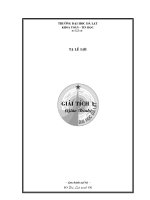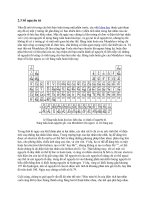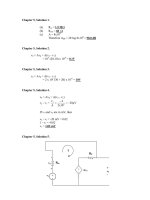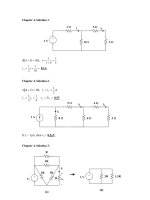Tài liệu Bài giải phần giải mạch P6 pptx
Bạn đang xem bản rút gọn của tài liệu. Xem và tải ngay bản đầy đủ của tài liệu tại đây (1.44 MB, 40 trang )
Chapter 6, Solution 1.
(
=+−==
−− t3t3
e6e25
dt
dv
Ci
)
10(1 - 3t)e
-3t
A
p = vi
= 10(1-3t)e
-3t
⋅ 2t e
-3t
= 20t(1 - 3t)e
-6t
W
Chapter 6, Solution 2.
22
11
)120)(40(
2
1
Cv
2
1
w ==
w
2
=
22
1
)80)(40(
2
1
2
=Cv
1
(
)
=−=−=∆
22
21
8012020www 160 kW
Chapter 6, Solution 3.
i = C =
−
=
−
5
160280
10x40
d
t
dv
3
480 mA
Chapter 6, Solution 4.
)0(vidt
C
1
v
t
o
+=
∫
∫
+1tdt4sin6
2
1
=
=
1 - 0.75 cos 4t
Chapter 6, Solution 5.
v =
∫
+
t
o
)0(vidt
C
1
For 0 < t < 1, i = 4t,
∫
−
=
t
o
6
t4
10x20
1
v
dt + 0 = 100t
2
kV
v(1) = 100 kV
For 1 < t < 2, i = 8 - 4t,
∫
+−=
−
t
1
6
)1(vdt)t48(
10x20
1
v
= 100 (4t - t
2
- 3) + 100 kV
Thus v (t) =
<<−−
<<
2t1,kV)2tt4(100
1t0,kVt100
2
2
Chapter 6, Solution 6.
6
10x30
dt
dv
Ci
−
==
x slope of the waveform.
For example, for 0 < t < 2,
3
10x2
10
d
t
dv
−
=
i =
mA150
10x2
10
x10x30
d
t
dv
3
6
==
−
−
C
Thus the current i is sketched below.
t (msec)
150
12
10
2
8
6
4
-150
i(t) (mA)
Chapter 6, Solution 7.
∫∫
+=+=
−
−
t
o
3
3
o
10dt10tx4
10x50
1
)t(vidt
C
1
v
=
=+10
50
t2
2
0.04k
2
+ 10 V
Chapter 6, Solution 8.
(a)
tt
BCeACe
dt
dv
C
600100
600100
−−
−−==
i
(1)
BABCACi 656001002)0(
−
−
=
→
−−== (2)
BAvv +=→=
−+
50)0()0( (3)
Solving (2) and (3) leads to
A=61, B=-11
(b)
J 52500104
2
1
)0(
2
1
32
===
−
xxxCvEnergy
(c ) From (1),
A 4.264.241041160010461100
60010060031003 tttt
eeexxxexxxi
−−−−−−
−−=−−=
Chapter 6, Solution 9.
v(t) =
()
(
)
∫
−−
+=+−
t
o
tt
Vet120dte16
21
1
v(2) = 12(2 + e
-2
) = 25.62 V
p = iv = 12 (t + e
-t
) 6 (1-e
-t
) = 72(t-e
-2t
)
p(2) = 72(2-e
-4
) = 142.68 W
Chapter 6, Solution 10
dt
dv
x
dt
dv
Ci
3
102
−
==
<<
<<
<<
=
s4t316t,-64
s 3t116,
s10,16
µ
µ
µ
tt
v
<<
<<
<<
=
s4t3,16x10-
s 3t10,
s10,1016
6
6
µ
µ
µ
tx
dt
dv
<<
<<
<<
=
s4t3kA, 32-
s 3t10,
s10,kA 32
)(
µ
µ
µ
t
ti
Chapter 6, Solution 11.
v =
∫
+
t
o
)0(vidt
C
1
For 0 < t < 1,
∫
==
−
−
t
o
3
6
t10dt10x40
10x4
1
v kV
v(1) = 10 kV
For 1 < t < 2,
kV10)1(vvdt
C
1
v
t
1
=+=
∫
For 2 < t < 3,
∫
+−=
−
−
t
2
3
6
)2(vdt)10x40(
10x4
1
v
= -10t + 30kV
Thus
v(t) =
<<+−
<<
<<⋅
3t2,kV30t10
2t1,kV10
1t0,kVt10
Chapter 6, Solution 12.
π−π==
−
4sin)(4(60x10x3
dt
dv
Ci
3
t)
=
- 0.7e π sin 4πt A
P = vi = 60(-0.72)π cos 4π t sin 4π t = -21.6π sin 8π t W
W =
∫∫
t dt ππ−=
t
o
8
1
o
8sin6.21pdt
=
π
π
π
8
8
6.
cos
21
8/1
o
= -5.4J
Chapter 6, Solution 13.
Under dc conditions, the circuit becomes that shown below:
i
2
50
Ω
20
Ω
+
−
60V
+
v
1
−
i
1
30 Ω
10
Ω
+
v
2
−
i
2
= 0, i
1
= 60/(30+10+20) = 1A
v
1
= 30i
2
= 30V, v
2
= 60-20i
1
= 40V
Thus, v
1
= 30V, v
2
= 40V
Chapter 6, Solution 14.
(a) C
eq
= 4C = 120 mF
(b)
30
4
C
4
C
1
eq
== C
eq
= 7.5 mF
Chapter 6, Solution 15.
In parallel, as in Fig. (a),
v
1
= v
2
= 100
C
2
+
v
2
−
C
1
+
−
100V
+
v
2
−
C
2
+
−
v
1
C
1
+
v
1
−
+
−
100V
(b)
(a)
w
20
= ==
− 262
100x10x20x
2
1
Cv
2
1
0.1J
w
30
=
=
− 26
100x10x30x
2
1
0.15J
(b) When they are connected in series as in Fig. (b):
,60100x
50
30
V
CC
C
v
21
2
1
==
+
=
v
2
= 40
w
20
=
=
− 26
60x10x30x
2
1
36 mJ
w
30
= =
− 26
4010x30
2
xx
1
24 mJ
Chapter 6, Solution 16
F 2030
80
80
14
µ
=→=
+
+= C
C
Cx
C
eq
Chapter 6, Solution 17.
(a) 4F in series with 12F = 4 x 12/(16) = 3F
3F in parallel with 6F and 3F = 3+6+3 = 12F
4F in series with 12F = 3F
i.e. C
eq
= 3F
(b)
C
eq
= 5 + [6 || (4 + 2)] = 5 + (6 || 6) = 5 + 3 = 8F
(c)
3F in series with 6F = (3 x 6)/9 = 6F
1
3
1
6
1
2
1
C
1
eq
=++=
C
eq
= 1F
Chapter 6, Solution 18.
For the capacitors in parallel
= 15 + 5 + 40 = 60 µF
1
eq
C
Hence
10
1
60
1
30
1
20
1
C
1
eq
=++=
C
eq
= 10 µF
Chapter 6, Solution 19.
We combine 10-, 20-, and 30-
µ
F capacitors in parallel to get 60
µ
F. The 60 -
µ
F
capacitor in series with another 60-
µ
F capacitor gives 30
µ
F.
30 + 50 = 80
µ
F, 80 + 40 = 120
µ
F
The circuit is reduced to that shown below.
12 120
12
80
120-
µ
F capacitor in series with 80
µ
F gives (80x120)/200 = 48
48 + 12 = 60
60-
µ
F capacitor in series with 12
µ
F gives (60x12)/72 = 10
µ
F
Chapter 6, Solution 20.
3 in series with 6 = 6x
3
/(9) = 2
2 in parallel with 2 = 4
4 in series with 4 = (4x4)/8 = 2
The circuit is reduced to that shown below:
20
1
6
2
8
6 in parallel with 2 = 8
8 in series with 8 = 4
4 in parallel with 1 = 5
5 in series with 20 = (5x20)/25 = 4
Thus C
eq
= 4 mF
Chapter 6, Solution 21.
4µF in series with 12µF = (4x12)/16 = 3µF
3µF in parallel with 3µF = 6µF
6µF in series with 6µF = 3µF
3µF in parallel with 2µF = 5µF
5µF in series with 5µF = 2.5µF
Hence C
eq
= 2.5µF
Chapter 6, Solution 22.
Combining the capacitors in parallel, we obtain the equivalent circuit shown below:
a b
40
µ
F
60 µF 30
µ
F
20
µ
F
Combining the capacitors in series gives
C , where
1
eq
10
1
30
1
20
1
60
1
C
1
1
eq
=++= C = 10µF
1
eq
Thus
C
eq
= 10 + 40 = 50 µF
Chapter 6, Solution 23.
(a) 3µF is in series with 6µF 3x6/(9) = 2µF
v
4µF
= 1/2 x 120 = 60V
v
2µF
= 60V
v
6µF
= =(
3
+
)60
36
20V
v
3µF
= 60 - 20 = 40V
(b)
Hence w = 1/2 Cv
2
w
4µF
= 1/2 x 4 x 10
-6
x 3600 = 7.2mJ
w
2µF
= 1/2 x 2 x 10
-6
x 3600 = 3.6mJ
w
6µF
= 1/2 x 6 x 10
-6
x 400 = 1.2mJ
w
3µF
= 1/2 x 3 x 10
-6
x 1600 = 2.4mJ
Chapter 6, Solution 24.
20µF is series with 80µF = 20x80/(100) = 16µF
14µF is parallel with 16µF = 30µF
(a) v
30µF
= 90V
v
60µF
= 30V
v
14µF
= 60V
v
20µF
=
=
+
60x
8020
80
48V
v
80µF
= 60 - 48 = 12V
(b)
Since w =
2
Cv
2
1
w
30µF
= 1/2 x 30 x 10
-6
x 8100 = 121.5mJ
w
60µF
= 1/2 x 60 x 10
-6
x 900 = 27mJ
w
14µF
= 1/2 x 14 x 10
-6
x 3600 = 25.2mJ
w
20µF
= 1/2 x 20 x 10
-6
x (48)
2
= 23.04mJ
w
80µF
= 1/2 x 80 x 10
-6
x 144 = 5.76mJ
Chapter 6, Solution 25.
(a) For the capacitors in series,
Q
1
= Q
2
C
1
v
1
= C
2
v
2
1
2
2
1
C
C
v
v
=
v
s
= v
1
+ v
2
=
2
1
21
22
1
2
v
C
CC
vv
C
C +
=+
s
21
1
2
v
CC
C
+
=v
Similarly,
s
21
2
1
v
CC
C
v
+
=
(b)
For capacitors in parallel
v
1
= v
2
=
2
2
1
1
C
Q
C
Q
=
Q
s
= Q
1
+ Q
2
=
2
2
21
22
2
1
Q
C
CC
C
C +
=+
or
Q
2
=
21
2
CC
C
+
s
21
1
1
Q
CC
C
Q
+
=
i =
dt
dQ
s
21
1
1
i
CC
C
+
=i ,
s
21
2
2
i
CC
C
+
=i
Chapter 6, Solution 26.
(a)
C
eq
= C
1
+ C
2
+ C
3
= 35µF
(b) Q
1
= C
1
v = 5 x 150µC = 0.75mC
Q
2
= C
2
v = 10 x 150µC = 1.5mC
Q
3
= C
3
v = 20 x 150 = 3mC
(c) w =
J150x35x
2
1
2
22
eq
µ=
vC
1
= 393.8mJ
Chapter 6, Solution 27.
(a)
20
7
20
1
10
1
5
1
C
1
C
1
C
1
C
1
321eq
=++=++=
C
eq
= =µF
7
20
2.857µF
(b)
Since the capacitors are in series,
Q
1
= Q
2
= Q
3
= Q = C
eq
v = =µV200x
7
20
0.5714mV
(c) w =
=µ= J200x
7
20
x
2
1
2
22
eq
vC
1
57.143mJ
Chapter 6, Solution 28.
We may treat this like a resistive circuit and apply delta-wye transformation, except that
R is replaced by 1/C.
C
a
C
b
C
c
50
µ
F
20
µ
F
30
1
40
1
30
1
30
1
10
1
40
1
10
1
C
1
a
+
+
=
=
10
2
40
1
10
1
40
=++
3
C
a
= 5µF
30
2
10
1
1200
1
300
1
400
1
C
1
6
=
++
=
C
b
= 15µF
15
4
40
1
1200
1
300
1
400
1
C
1
c
=
++
=
C
c
= 3.75µF
C
b
in parallel with 50µF = 50 + 15 = 65µF
C
c
in series with 20µF = 23.75µF
65µF in series with 23.75µF =
F39.17
75.88
75.23x65
µ=
17.39µF in parallel with C
a
= 17.39 + 5 = 22.39µF
Hence C
eq
= 22.39µF
Chapter 6, Solution 29.
(a) C in series with C = C/(2)
C/2 in parallel with C = 3C/2
2
C3
in series with C =
5
C3
2
C
5
2
C3
Cx
=
5
C
3 in parallel with C = C +
=
5
C
3
1.6 C
(b)
2C
C
e
q
2C
C
1
C2
1
C2
1
C
1
eq
=+=
C
eq
= C
Chapter 6, Solution 30.
v
o =
∫
+
t
o
)0(iidt
C
1
For 0 < t < 1, i = 60t mA,
kVt100tdt60
10x3
10
v
2
t
o
6
3
o
=+=
∫
−
−
v
o
(1) = 10kV
For 1< t < 2, i = 120 - 60t mA,
v
o
=
∫
+−
−
−
t
1
o
6
3
)1(vdt)t60120(
10x3
10
t
+
= [40t – 10t
2
kV10]
1
= 40t – 10t
2
- 20
<<−−
<<
=
2t1,kV20t10t40
1t0,kVt10
)t(v
2
2
o
Chapter 6, Solution 31.
<<+−
<<
<<
=
5t3,t1050
3t1,mA20
1t0,tmA20
)t(i
s
C
eq
= 4 + 6 = 10µF
)0(vidt
C
1
v
t
o
eq
+=
∫
For 0 < t < 1,
∫
−
−
=
t
o
6
3
t20
10x10
10
v dt + 0 = t
2
kV
For 1 < t < 3,
∫
+−=+=
t
1
3
kV1)1t(2)1(vdt20
10
10
v
kV1t2 −=
For 3 < t < 5,
∫
+−=
t
3
3
)3(vdt)5t(10
10
10
v
kV11t5tkV55t
2t
3
2
+−=++−=
<<+−
<<−
<<
=
5t3,kV11t5t
3t1,kV1t2
1t0,kVt
)t(v
2
2
dt
dv
10x6
dt
dv
Ci
6
11
−
==
=
<<−
<<
<<
5t3,mA3012
3t1,mA12
1t0,tmA12
dt
dv
10x4
dt
dv
Ci
6
21
−
==
<<−
<<
<<
=
5t3,mA20t8
3t1,mA8
1t0,tmA8
Chapter 6, Solution 32.
(a) C
eq
= (12x60)/72 = 10
µ
F
13001250501250)0(30
1012
10
2
0
0
2
1
2
6
3
1
+−=+−=+=
−−−
−
−
∫
t
t
t
tt
eevdte
x
v
23025020250)0(30
1060
10
2
0
0
2
2
2
6
3
2
−=+=+=
−−−
−
−
∫
t
t
t
tt
eevdte
x
v
(b)
At t=0.5s,
03.138230250,15.84013001250
1
2
1
1
−=−==+−=
−−
evev
J 235.4)15.840(1012
2
1
26
12
==
−
xxxw
F
µ
J 1905.0)03.138(1020
2
1
26
20
=−=
−
xxxw
F
µ
J 381.0)03.138(1040
2
1
26
40
=−=
−
xxx
F
µ
w
Chapter 6, Solution 33
Because this is a totally capacitive circuit, we can combine all the capacitors using
the property that capacitors in parallel can be combined by just adding their
values and we combine capacitors in series by adding their reciprocals.
3F + 2F = 5F
1/5 +1/5 = 2/5 or 2.5F
The voltage will divide equally across the two 5F capacitors. Therefore, we get:
V
Th
= 7.5 V, C
Th
= 2.5 F
Chapter 6, Solution 34.
i = 6e
-t/2
2/t3
e
2
1
)6(10x10
dt
di
L
−−
==
v
= -30e
-t/2
mV
v(3) = -300e
-3/2
mV = -0.9487 mV
p = vi = -180e
-t
mW
p(3) = -180e
-3
mW = -0.8 mW
Chapter 6, Solution 35.
dt
di
Lv =
==
∆∆
=
−
)2/(6.0
10x60
t/i
V
L
3
200 mH
Chapter 6, Solution 36.
V)t2sin)(2)(12(10x
4
1
dt
di
Lv
3
−==
−
=
- 6 sin 2t mV
p = vi = -72 sin 2t cos 2t mW
But 2 sin A cos A = sin 2A
p = -36 sin 4t mW
Chapter 6, Solution 37.
t100cos)100(4x10x12
dt
di
Lv
3−
==
= 4.8 cos 100t V
p = vi = 4.8 x 4 sin 100t cos 100t = 9.6 sin 200t
w =
t200sin6.9pdt
t
o
200/11
o
∫∫
=
Jt200cos
200
6.9
200/11
o
−=
= =−π− mJ)1(cos48 96 mJ
Chapter 6, Solution 38.
()
dtte2e10x40
d
t
di
Lv
t2t23 −−−
−==
= 240 0t,mVe)t1(
t2
>−
−
Chapter 6, Solution 39
)0(iidt
L
1
i
d
t
di
Lv
t
0
+
∫
=→=
1dt)4t2t3(
10x200
1
i
t
0
2
3
+
∫
++=
−
1)t4tt(5
t
0
23
+++=
i(t) =
5t
3
+ 5t
2
+ 20t + 1 A
Chapter 6, Solution 40
dt
di
x
dt
di
Lv
3
1020
−
==
<<+
<<
<<
=
ms 4t310t,40-
ms 3t110t,-20
ms 10,10 tt
i
<<
<<
<<
=
ms 4t3,10x10
ms 3t1,10x10-
ms 10,1010
3
3
3
tx
dt
di
<<
<<
<<
=
ms 4t3V, 200
ms 3t1V, 200-
ms 10,V 200 t
v
which is sketched below.
v(t) V
200
0 1 2 3 4 t(ms)
-200
Chapter 6, Solution 41.
()
∫∫
+−
=+=
−
t
o
t2
t
0
3.0dt2120
2
1
)0(ivdt
L
1
i
=
Aetet
tt
o
t
7451030
2
1
22
−+=+
+
−−
10
At t = ls, i = 10 - 4.7 + 5e
-2
= 5.977 A
L
2
1
w = i
2
= 35.72J
Chapter 6, Solution 42.
∫∫
−=+=
t
o
t
o
1dt)t(v
5
1
)0(ivdt
L
1
i
For 0 < t < 1,
∫
−=−=
t
0
1t21dt
5
10
i
A
For 1 < t < 2, i = 0 + i(1) = 1A
For 2 < t < 3, i =
∫
+=+ 1t2)2(idt10
5
1
2
t
= 2t - 3 A
For 3 < t < 4, i = 0 + i(3) = 3 A
For 4 < t < 5, i =
∫
+=+
t
4
t
4
3t2)4(idt10
5
1
= 2t - 5 A
Thus,
21, 0 1
1, 1 2
() 2 3 , 2 3
3, 3 4
25, 4
tA t
At
it t A t
At
tt
−<
5
<
<
<
=− <<
<
<
−<
<
Chapter 6, Solution 43.
w = L )(Li
2
1
)t(Li
2
1
idt
2
t
−∞−=
∫
∞−
()
010x60x10x80x
2
1
33
−=
−−
=
144 µJ
Chapter 6, Solution 44.
()
∫∫
−+=+=
t
o
t
t
o
o
1dt)t2cos104(
5
1
tivdt
L
1
i
=
0.8t + sin 2t -1
Chapter 6, Solution 45.
i(t) =
∫
+
t
o
)0(i)t(v
L
1
For 0 < t < 1, v = 5t
∫
−
=
t
o
3
t5
10x10
1
i
dt + 0
= 0.25t
2
kA
For 1 < t < 2, v = -10 + 5t
∫
++−=
−
t
1
3
)1(idt)t510(
10x10
1
i
∫
= ( +−
t
1
kA25.0dt)1t5.0
= 1 - t + 0.25t
2
kA
<<+−
<<
=
2t1,kAt25.0t1
1t0,kAt25.0
)t(i
2
2
Chapter 6, Solution 46.
Under dc conditions, the circuit is as shown below:
2
Ω
+
v
C
−
3 A
i
L
4
Ω
By current division,
=
+
= )3(
24
4
i
L
2A, v
c
= 0V
L
2
1
w
L
= =
=
22
L
)2(
2
1
2
1
i 1J
C
2
1
w
c
= == )v)(2(
2
1
v
2
c
0J
Chapter 6, Solution 47.
Under dc conditions, the circuit is equivalent to that shown below:
R
+ v
C
−
5 A
i
L
2
Ω
,
2
R
10
)5(
2
R
2
i
L
+
=
+
=
2
R
R10
Riv
Lc
+
==
2
2
62
cc
)2R(
R100
x10x80Cv
2
1
w
+
==
−
2
32
1L
)2R(
100
x10x2Li
2
1
w
+
==
−
If w
c
= w
L
,
2
3
2
2
6
)2R(
100x10x2
)2Rx(
R100
x10x80
+
=
−
−
80 x 10
-3
R
2
= 2
R =
5Ω
Chapter 6, Solution 48.
Under dc conditions, the circuit is as shown below:
+
v
C2
−
+
−
+
v
C1
−
i
L1
6
Ω
4 Ω
i
L2
30V
=
+
==
64
30
ii
2
L
1
L
3A
==
1
L
1
C
i6v 18V
=
2
C
v
0V
Chapter 6, Solution 49.
(a)
()
=+=++= 36544165L
eq
7H
(b)
()
==+= 41266112L
eq
3H
(c)
()
==+= 446324L
eq
2H
Chapter 6, Solution 50.
()
63124510L
eq
++=
= 10 + 5||(3 + 2) = 10 + 2.5 =
12.5 mH
Chapter 6, Solution 51.
10
1
30
1
20
1
60
1
L
1
=++=
L = 10 mH
()
45
35x10
102510L
eq
=+=
=
7.778 mH
Chapter 6, Solution 52.
3//2//6 = 1H, 4//12 = 3H
After the parallel combinations, the circuit becomes that shown below.
3H
a
1H
1 H b
L
ab
= (3+1)//1 = (4x1)/5 = 0.8 H
Chapter 6, Solution 53.
[]
)48(6)128(58106L
eq
+++++=
416)44(816 +=++=
L
eq
= 20 mH
Chapter 6, Solution 54.
()
126010)39(4L
eq
+++=
34)40(124 +=++=
L
eq
= 7H
Chapter 6, Solution 55.
(a) L//L = 0.5L, L + L = 2L
L
LL
LLx
LLLLL
eq
4.1
5.02
5.02
5.0//2 =
+
+=+=
(b) L//L = 0.5L, L//L + L//L = L
L
eq
= L//L = 0.5L
Chapter 6, Solution 56.
3
L
L
3
1
LLL ==
Hence the given circuit is equivalent to that shown below:
L
L/3
L
L/3
=
+
=
+=
L
3
5
L
L
3
5
Lx
L
3
2
LLL
eq
L
8
5
Chapter 6, Solution 57.
Let
dt
di
L
eq
v
=
(1)
221
v
dt
di
4vvv +=+= (2)
i = i
1
+ i
2
i
2
= i – i
1
(3)
3
v
dt
di
or
dt
di
3v
211
2
== (4)
and
0
dt
di
5
dt
di
2v
2
2
=++−
dt
di
5
dt
di
2v
2
2
+= (5)
Incorporating (3) and (4) into (5),
3
v
5
dt
di
7
dt
di
5
dt
di
5
dt
di
2v
21
2
−=−+=
dt
di
7
3
5
1v
2
=
+
dt
di
8
35
v
2
=
Substituting this into (2) gives
dt
di
8
35
dt
di
4v +=
dt
di
8
67
=
Comparing this with (1),
==
8
67
L
eq
8.375H
Chapter 6, Solution 58.
===
dt
di
3
dt
di
Lv 3 x slope of i(t).
Thus v is sketched below:
6
t (s)
7 5
1
4
3 2
-6
v(t) (V)
6
Chapter 6, Solution 59.
(a)
()
dt
di
LLv
21s
+=
21
s
LL
v
dt
di
+
=
,
dt
di
L
11
=
v
dt
di
L
22
=
v
,v
LL
L
v
s
21
1
1
+
=
s
21
2
L
v
LL
L
v
+
=
(b)
dt
di
L
dt
di
Lvv
2
2
1
12i
===
21s
iii +
=
(
)
21
21
21
21
s
LL
LL
v
L
v
L
v
dt
di
dt
di
dt
di
+
=+=+=
∫∫
=
+
== dt
dt
di
LL
LL
L
1
vdt
L
1
i
s
21
21
11
1
s
21
2
i
LL
L
+









